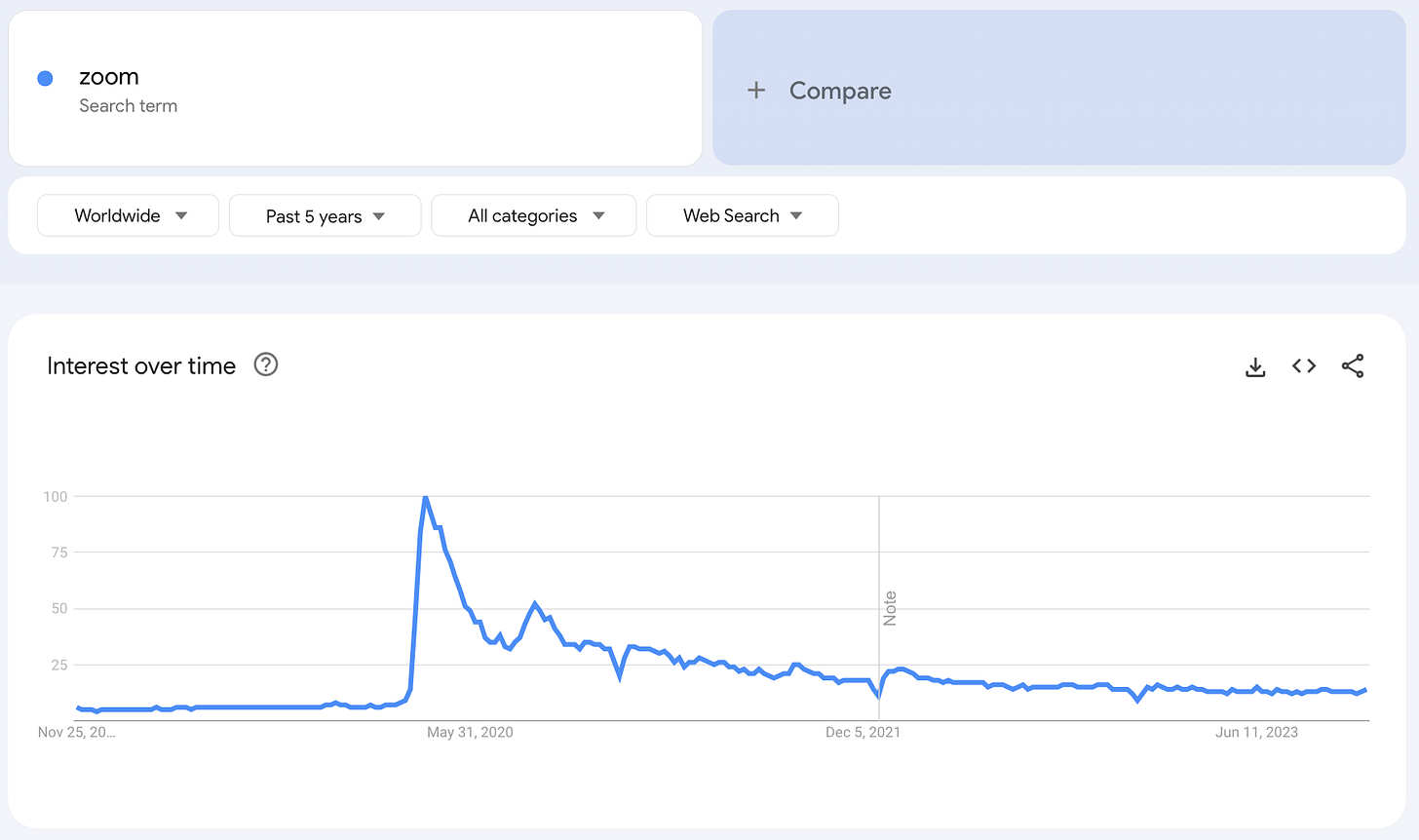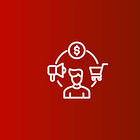Why 2025 Should Be the Year You Start a Substack
Platform growth, network effects, and monetization, oh my.
Welcome to the first edition of Really Good Business Ideas!
As the name suggests, this publication is all about sharing really good business ideas. Ideas for businesses someone should start. Ideas for how to grow those businesses. Ideas for how those businesses can become more profitable.
However, unlike a lot of content in the business space, Really Good Business Ideas will be backed by solid research and analysis designed to help you make better decisions. Insights over opinions. Action over contemplation.
Since this publication is a business that lives on Substack, I’m sharing my research on this exact business opportunity today.
The Opportunity 💰
The best time to start a Substack is right now.
Substack launched in 2017, and like most startups, it got off to a slow start. Luckily for Substack, COVID-19 happened. Search interest in Substack (a decent proxy for brand awareness) started to take off in April 2020 at the start of the pandemic. Luckily for all of us, it has continued on a strong trajectory since then.

Many companies that capitalized on COVID-19 to accelerate their growth cannot say the same. Zoom and Clubhouse, for example. Both benefited greatly from the transition to people spending more time at home on their devices, but both have also seen interest in their products decline greatly from their pandemic peaks.


Of course, strong search interest growth for Substack isn’t enough on its own to make this an exciting opportunity. That upward trajectory is important for future growth, but we also need to know that readers are actually using Substack—and writers are actually earning an income.
It turns out, monthly active subscriptions and the number of writers earning money on Substack have both grown significantly since 2020 and appear to be on a path of continued growth.


As of March 2025, there are more than 5 million paid subscriptions on Substack.1 Four months ago, there were only 4 million paid subscriptions.2 This kind of growth is extremely rare!
Plus more 50K writers earn money from Substack, with the top 10 publishers collectively earning more than $40 million a year.3 That’s up almost 200% from two years ago when only 17K writers earned money from Substack subscriptions, with the top 10 publishers collectively earning more than $25 million.4
You can see how this breaks down with my analysis of the top-earning publications.
So Substack is officially mainstream, and publishers on the platform are primed to benefit significantly from its continued growth for one key reason: network effects.
What Are Network Effects?
Network effects describe the phenomenon where a business’s value increases as more people use its products or services. These effects are great for business because growth becomes increasingly efficient over time.
Here’s an example of network effects in action.
Each person who uses Dropbox shares a folder with an average of five others.
On average, two of those five people have never used Dropbox before.
So, each new customer who starts using Dropbox is worth three new customers: the first plus the two more they refer.
The more customers Dropbox acquires, the more customers they get.
Eventually, businesses reach a saturation point where the network effects plateau, but they’re incredibly good for growth up until that point.

Network Effects and Marketplaces (Like Substack)
Dropbox is a one-sided business: customers buy storage space from Dropbox. However, two-sided businesses, known as marketplaces, can benefit from network effects, too. In a marketplace, users can be buyers or suppliers. For example, Etsy has users who sell products and users who buy products. Both types of users are necessary for the business to work.
In marketplaces, network effects can benefit the business (e.g., Etsy) and the supply-side users. Substack is one such example. The more subscribers Substack acquires, the better for Substack and its publishers.
This works in a couple of ways.
Substack publications can be promoted across the platform through several features. The more users on the platform, the more people can be exposed to your Publication.
After someone buys their first paid subscription to a Substack publication, it’s much easier for them to purchase additional paid subscriptions. Once their credit card is in the system, buying additional subscriptions becomes a one-click checkout. This means that as the Substack platform grows, the number of easily converted subscribers for your publication grows, too.
So you’re getting exposure to an ever-growing population of Substack users, and that population has less friction to subscribing than other populations coming to Substack for the first time.
But don’t just take my word for it.
In a June 2022 blog post, Substack explained that it now generates 1 in 3 new subscriptions for Publications on the platform through features like recommendations, leaderboards, and Publication embeds.
Lenny Rachitsky, the author of the top business Publication on Substack, Lenny’s Letter, confirmed this claim and more when he tweeted that 70% of his new subscribers come from Substack.

Bigger publications undoubtedly benefit disproportionately from these network effects. Just like Dropbox, the more subscribers they have, the more subscribers they get. They have more subscribers to recommend their publication, and the Substack platform has more reason to promote their publications to new readers because they’re already so popular.
So, while the average might be 30%, top publications like Lenny’s Newsletter might be getting upwards of 70% of new subscribers from network effects, and conversely, smaller publishers might only get 10% at first.
But there’s a great opportunity for new publishers to tap into this growing network as they grow their own audiences. As new publications grow, they’ll be able to tap into the network more and more.
Note that this is a very brief overview of network effects. I’ll explain network effects and how you can leverage them in your business more in a future article, so be sure to subscribe if you don’t want to miss it.
Starting an online publication isn’t for everyone. Let’s talk about who would benefit most from this business opportunity.
Who Is This Opportunity Good For? 🎯
There are many ways to earn a living, and I’ll cover many of them over the coming months. Specifically starting a Substack publication is going to be a good choice for the following people:
Someone who likes to write
If you love to write or create content, a publication business like a Substack is a great choice. Using the Substack platform, you can easily monetize your writing—or even a podcast—through paid subscriptions.
Someone who isn’t tech-savvy
If you’ve wanted to create a blog but the thought of building a website fills you with dread, Substack is a great choice. They make it extremely easy to create a professional-looking site to host your content, and key features like payments are already built in.
Someone with a strong reputation in their industry
Audience building takes time. If you already have a strong reputation in your industry as an expert or insider with a unique perspective, you probably already have a network you can leverage to start building your audience.
Someone with specialized expertise or a unique perspective
Even if you’re not well-known within your industry, if you have specialized expertise or a unique perspective that most people don’t have access to, you may be able to build an audience faster because of the distinct value you can provide.
Someone who doesn’t have a lot of startup capital
If you don’t have a lot of startup capital, a newsletter is a great option for starting a business. The most important resource will be your time spent creating content. With a platform like Substack, you don’t really need to invest in web design and development or setting up email automation software. It’s completely free to sign up and start publishing on Substack. Once you start earning revenue, Substack will take a 10% cut.
Someone who is looking to start something on the side
Not everyone wants to quit their job to start a business. Fortunately, you don’t have to. A Substack newsletter is a great option if you’re looking to start building a new income stream on the side of your current job or commitments. You can scale your publishing schedule to fit your life and even use a newsletter to help build your personal brand without quitting your job.
Someone who doesn’t want to hire employees
If you don’t want to worry about hiring, managing, and paying employees, a Substack publication is a great option. In most cases, you can create and manage it independently, hiring occasional contractors when you need help.
PS. If you’re ready to start a Substack, I have six research-backed ideas ready to go!
How To Monetize a Substack Publication
There are more ways to monetize a Substack publication than you might think. Considering a broader set of monetization options might help more people understand how a publication can fit into their portfolio of projects.
Subscription Fees
The first and most obvious way is to charge a subscription fee. Substack is really good at this, and if you’re choosing to start a publication on Substack, their paid subscription feature is probably why.
Speaking of paid subscriptions…
Ads or Sponsored Content
Substack Publications can be monetized with ads and other sponsored content like any newsletter. While I’m not aware of an easy way to connect a Substack publication to an ad network, native ads where the promotion is naturally integrated into the content are still easy to do.
In a recent article on ByteByteGo, this ad is a great example of how they can be organically incorporated into content without ad platforms. Since the article is all about passkeys, including an ad for a passkey product will be relevant. No additional audience targeting is needed.

If you want to monetize with ad placements, you’ll need a way to inform potential advertisers. Here’s a great example of a sponsorships page on How They Grow. It succinctly explains who the audience is, what sponsorship looks like, how much it costs, and how to book.
Affiliate Links
Affiliate links are another great way to monetize content. If your Substack will be referencing products, you can sign up for the affiliate programs for those products and get a commission for any sales your publication refers.
For example, this gift guide includes Amazon affiliate links for products the author recommends. If readers buy those products—or any other products—after following the affiliate link, the author will receive a commission on the sale. Notably, this post is not behind a paywall, so they can use it to monetize free subscribers.

Lead Generation
Lastly, if you sell your own products, you can use your Substack publication as a funnel for your book, consulting package, course, or whatever product or service you want to generate leads for.
A great example of this is JP Castlin, author of my favorite Substack on strategy, using his publication to promote his speaking services.

Coming Up Next Week 📩
By now, you should have a pretty good idea of how much opportunity there is with Substack and whether you want to explore it more. Over the next few weeks, we’ll explore the data behind current Substack publications to extract insights and develop a playbook for succeeding on Substack.
Join me next week for an analysis of the highest-priced Substack publications.
To endless possibilities,
Casandra








Indeed, Substack is a great place to grow. I’ve just hit 1,000 subscribers after starting from zero 18 months ago.
There are a few niggling issues with Substack that we need to keep a close eye on.
Recommendations have been amazing but there’s a limit to the number of newsletters each person can read in a week. Lennys newsletter was one of the first out the block but those following are competing against an avalanche of newsletters.
To combat this, Substack needs to have a steady flow of new readers coming into the top of its funnel. I haven’t seen any stats on this but your first graph is comforting to some extent.
In terms of going paid, you need to be both realistic and focused on your value proposition. People subscribe for free because they WANT to read your work. They will become PAID if they NEED to read your work.
Great article! Looking forward to learning more!